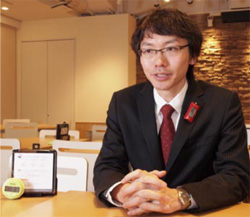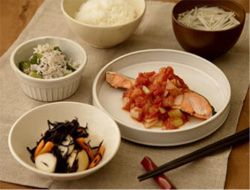Home > Highlighting JAPAN > Highlighting Japan APRIL 2012 > The Superior Cafeteria
Highlighting JAPAN
COVER STORY: Food, Glorious Japanese Food
The Superior Cafeteria
Measuring equipment manufacturer Tanita is famous for having a staff cafeteria that serves a healthy menu. In January this year, the Marunouchi Tanita Shokudo restaurant (shokudo means "cafeteria") was opened to the general public in Marunouchi, the center of Tokyo's business district. The Japan Journal's Sawaji Osamu talks to Shuji Minami, the man in charge of the Marunouchi Tanita Shokudo.

Shuji Minami at the Marunouchi Tanita Shokudo. Beside him, a timer (mealtimes should last at least 20 minutes) and weighing machine.
Credit: TADASHI AIZAWA
How did Tanita come to develop such a health-oriented cafeteria back in 1999?
Shuji Minami: Tanita is a company that manufactures measuring instruments, such as scales and devices for measuring body fat. That is to say, we are a company that measures health. That is why we put a lot of energy into maintaining the health of our staff. As part of these efforts, we initially started the staff cafeteria to serve a healthy menu. However, in the beginning we focused on an anti-obesity menu that reduced the calories of the meals above all else, and so we heard nothing but negative feedback from staff, who said that the food was "unappetizing" or "not filling enough" because the food didn't have much flavor and the servings were small.
What specific innovations did you make to eliminate this kind of negativity?
The basic menu is a Japanese-style teishoku set meal, consisting of rice, miso soup, vegetables, and a main course of meat and vegetables. Even in normal circumstances this kind of food is quite healthy, but every day the nutritionists in the staff cafeteria strove to achieve flavors that exploit the natural flavor of the raw materials while using salt and oil as little as possible. For example, by using dashi stock made from fish and kombu (kelp), as well as vinegar and chili, we can give accents to the flavor without using salt. This makes the food taste better, while still holding back on the salt and calories.
We also only boil vegetables lightly, leaving them a little harder than normal so that people have to chew them thoroughly. We recommend that people take at least twenty minutes to finish their food. This is because if you eat too quickly you don't get a full signal, and so you get hungry again straight away.
Our menu now includes more than 200 items, and most of these are around 500 kilocalories, with less than three grams of salt and at least 200 grams of vegetables.

This set meal comprising salmon with a vegetable sauce, rice, enoki mushroom soup, vinegared cucumber with dried whitebait and simmered hijiki seaweed weighs in at just 449 kilocalories.
Credit: COURTESY OF TANITA
What were the benefits for the people using the cafeteria?
Simply by eating lunch at the staff cafeteria, some people were able to lose nine kilograms over twelve months or three kilograms over four months, even without making any other changes to their diet. There was even one person who succeeded in losing fifteen kilograms over twelve months by taking a cue from the meals at the staff cafeteria, and starting to cook the same kinds of meals at home for breakfast and dinner.
Other changes experienced by many users were better cholesterol numbers, eating smaller meals as a matter of course, and catching colds less easily.
Why did you open the Marunouchi Tanita Shokudo restaurant?
In February 2010, we published a recipe book introducing the menus used in the Tanita staff cafeteria, which became a best seller, selling more than 4.7 million copies. We then received a lot of feedback from readers saying that they wanted to actually try the food for themselves. We opened the Marunouchi Tanita Shokudo in January this year, to respond to this kind of feedback from customers. We have had customers from all over Japan, and not just the company workers from the nearby Marunouchi area. The reaction from most patrons has been along the lines of "The food was delicious, much more flavorsome than I expected."
There are two options—a set menu that changes daily that is the same as the staff cafeteria and another set menu that changes weekly, this being an original of Marunouchi Tanita Shokudo. On each table there is a weighing machine for measuring the weight of the rice and a timer for keeping track of the time spent eating.
There is also an administration nutritionist permanently stationed at the cafeteria. Customers can receive free counseling about their eating habits after taking measurements using the latest body composition meter.
In the future we hope to further brush up our menu to assist people with healthy eating habits.
© 2009 Cabinet Office, Government of Japan






